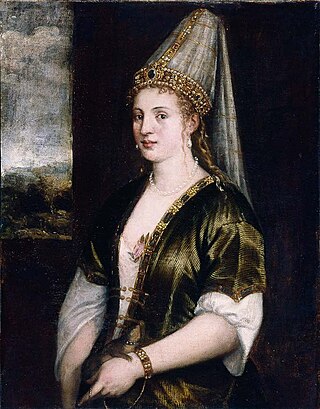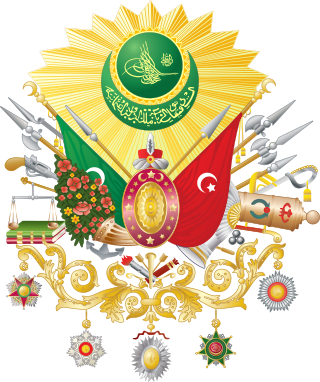Related Research Articles

Osman II, also known as Osman the Young, was the sultan of the Ottoman Empire from 26 February 1618 until his regicide on 20 May 1622.

Mehmet Fuat Köprülü, also known as Köprülüzade Mehmed Fuad, was a highly influential Turkish sociologist, Turkologist, scholar, Minister of Foreign Affairs and Deputy Prime Minister of the Republic of Turkey. A descendant of the prominent Köprülü family, Fuat Köprülü was a key figure in the intersection of scholarship and politics in early 20th century Turkey.

Hürrem Sultan, also known as Roxelana, was the chief consort and legal wife of the Ottoman Sultan Suleiman the Magnificent. She became one of the most powerful and influential women in Ottoman history, and as well a prominent figure during the period known as the Sultanate of Women.

Valide Sultan was the title held by the mother of a ruling sultan of the Ottoman Empire. The Ottomans first formally used the title in the 16th century as an epithet of Hafsa Sultan, mother of Sultan Suleyman I, superseding the previous epithets of Valide Hatun, mehd-i ulya. or "the nacre of the pearl of the sultanate".

Hatice Turhan Sultan was the first Haseki sultan of the Ottoman sultan Ibrahim and Valide sultan as the mother of Mehmed IV. Turhan was prominent for the regency of her young son and her building patronage. She and Kösem Sultan are the only two women in Ottoman history to be regarded as official regents and had supreme control over the Ottoman Empire. As a result, Turhan became one of the prominent figures during the era known as Sultanate of Women.

The Imperial Harem of the Ottoman Empire was the Ottoman sultan's harem – composed of the wives, servants, female relatives and the sultan's concubines – occupying a secluded portion (seraglio) of the Ottoman imperial household. This institution played an important social function within the Ottoman court, and wielded considerable political authority in Ottoman affairs, especially during the long period known as the Sultanate of Women.

The Köprülü era was a period in which the Ottoman Empire's politics were frequently dominated by a series of grand viziers from the Köprülü family. The Köprülü era is sometimes more narrowly defined as the period from 1656 to 1683, as it was during those years that members of the family held the office of grand vizier uninterruptedly, while for the remainder of the period they occupied it only sporadically.

In the Ottoman Empire, women enjoyed a diverse range of rights and were limited in diverse ways depending on the time period, as well as their religion and class. The empire, first as a Turkoman beylik, and then a multi-ethnic, multi-religious empire, was ruled in accordance to the qanun, the semi-secular body of law enacted by Ottoman sultans. Furthermore, the relevant religious scriptures of its many confessional communities played a major role in the legal system, for the majority of Ottoman women, these were the Quran and Hadith as interpreted by Islamic jurists, often termed sharia. Most Ottoman women were permitted to participate in the legal system, purchase and sell property, inherit and bequeath wealth, and participate in other financial activities, rights which were unusual in the rest of Europe until the 19th century.

Ayşe Hafsa Sultan, was a concubine of Selim I and the mother of Suleiman the Magnificent. She was the first Valide Sultan of the Ottoman Empire and, during the period between her son's enthronement in 1520 until her death in 1534, she was one of the most influential women in the Ottoman Empire.

Saliha Dilaşub Sultan, also known as Aşub Sultan or Aşube Sultan, was a consort of Ottoman Sultan Ibrahim and Valide Sultan to their son Suleiman II.
Ayşe Sineperver Sultan, also known as Ayşe Sineperver Kadın, was a consort of Ottoman Sultan Abdul Hamid I, and Valide Sultan to their son Sultan Mustafa IV of the Ottoman Empire.

Şah Sultan was an Ottoman princess, daughter of Sultan Selim I and one of his concubines. She was the half-sister of Sultan Suleiman the Magnificent.

Gülfem Hatun was a lady-in-waiting in the harem of Ottoman sultan Suleiman the Magnificent.

Halime Sultan was a consort of Sultan Mehmed III, and the mother of Sultan Mustafa I. The first woman to be Valide Sultan twice and the only to be Valide twice of a same son. She had at least four children with Mehmed: two sons Şehzade Mahmud and Mustafa I, and two daughters, Hatice Sultan and Şah Sultan. She was de facto co-ruler as Valide Sultan from 22 November 1617 to 26 February 1618 and from 19 May 1622 to 10 September 1623, because her son was mentally instable. Halime was also one of the prominent figures during the era known as the Sultanate of Women.

Fatma Sultan Constantinople) was an Ottoman princess. She was the daughter of Sultan Ahmed I and Kösem Sultan, sister of Murad IV and Ibrahim, and the paternal aunt of Mehmed IV. She is known for her many political marriages.
Ayşe Sultan was a consort of Sultan Osman II of the Ottoman Empire.
Ayşe Sultan was an Ottoman princess, daughter of Sultan Murad III and Safiye Sultan, as well as sister of Sultan Mehmed III of the Ottoman Empire.
Fatma Sultan was an Ottoman princess, daughter of Sultan Selim II of the Ottoman Empire and his favorite Nurbanu Sultan. She was the granddaughter of Suleiman the Magnificent and Hurrem Sultan, sister of Sultan Murad III and aunt of Sultan Mehmed III.

The Sultanate of Women was a period when some consorts, mothers, sisters and grandmother of the sultans of the Ottoman Empire exerted extraordinary political influence.
Saliha Canfeda Hatun was a lady-in-waiting to Nurbanu Sultan and Sultan Murad III of the Ottoman Empire.
References
- ↑ "Leslie Peirce", a New York University profile
- 1 2 "the Silver Dialogues"